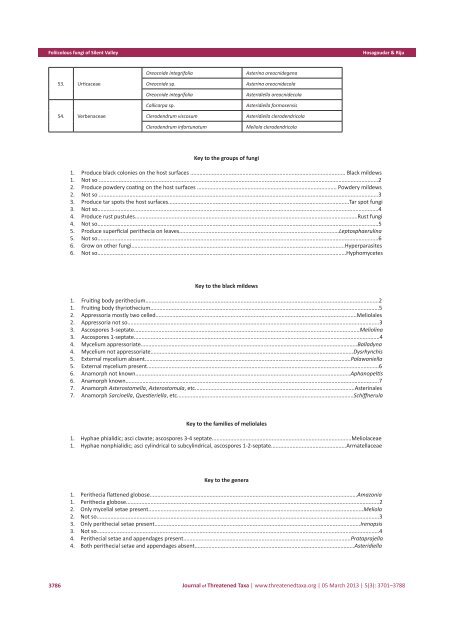PDF - Journal of Threatened Taxa
PDF - Journal of Threatened Taxa
PDF - Journal of Threatened Taxa
You also want an ePaper? Increase the reach of your titles
YUMPU automatically turns print PDFs into web optimized ePapers that Google loves.
Foliicolous fungi <strong>of</strong> Silent ValleyHosagoudar & Riju53. Urticaceae54. VerbenaceaeOreocnide integrifoliaOreocnide sp.Oreocnide integrifoliaCallicarpa sp.Clerodendrum viscosumClerodendrum infortunatumAsterina oreocnidegenaAsterina oreocnidecolaAsteridiella oreocnidecolaAsteridiella formosensisAsteridiella clerodendricolaMeliola clerodendricolaKey to the groups <strong>of</strong> fungi1. Produce black colonies on the host surfaces ..................................................................................................... Black mildews1. Not so ......................................................................................................................................................................................22. Produce powdery coating on the host surfaces ........................................................................................... Powdery mildews2. Not so ......................................................................................................................................................................................33. Produce tar spots the host surfaces......................................................................................................................Tar spot fungi3. Not so.......................................................................................................................................................................................44. Produce rust pustules.................................................................................................................................................Rust fungi4. Not so.......................................................................................................................................................................................55. Produce superficial perithecia on leaves........................................................................................................Leptosphaerulina5. Not so.......................................................................................................................................................................................66. Grow on other fungi...........................................................................................................................................Hyperparasites6. Not so..................................................................................................................................................................HyphomycetesKey to the black mildews1. Fruiting body perithecium........................................................................................................................................................21. Fruiting body thyriothecium.....................................................................................................................................................52. Appressoria mostly two celled...................................................................................................................................Meliolales2. Appressoria not so....................................................................................................................................................................33. Ascospores 3-septate...................................................................................................................................................Meliolina3. Ascospores 1-septate................................................................................................................................................................44. Mycelium appressoriate.............................................................................................................................................Balladyna4. Mycelium not appressoriate....................................................................................................................................Dysrhynchis5. External mycelium absent......................................................................................................................................Palawaniella5. External mycelium present.......................................................................................................................................................66. Anamorph not known............................................................................................................................................Aphanopeltis6. Anamorph known.....................................................................................................................................................................77. Anamorph Asterostomella, Asterostomula, etc........................................................................................................Asterinales7. Anamorph Sarcinella, Questieriella, etc...................................................................................................................SchiffnerulaKey to the families <strong>of</strong> meliolales1. Hyphae phialidic; asci clavate; ascospores 3-4 septate...........................................................................................Meliolaceae1. Hyphae nonphialidic; asci cylindrical to subcylindrical, ascospores 1-2-septate.................................................ArmatellaceaeKey to the genera1. Perithecia flattened globose.......................................................................................................................................Amazonia1. Perithecia globose.....................................................................................................................................................................22. Only mycelial setae present............................................................................................................................................Meliola2. Not so........................................................................................................................................................................................33. Only perithecial setae present......................................................................................................................................Irenopsis3. Not so........................................................................................................................................................................................44. Perithecial setae and appendages present.............................................................................................................Prataprajella4. Both perithecial setae and appendages absent........................................................................................................Asteridiella3786<strong>Journal</strong> <strong>of</strong> <strong>Threatened</strong> <strong>Taxa</strong> | www.threatenedtaxa.org | 05 March 2013 | 5(3): 3701–3788

















